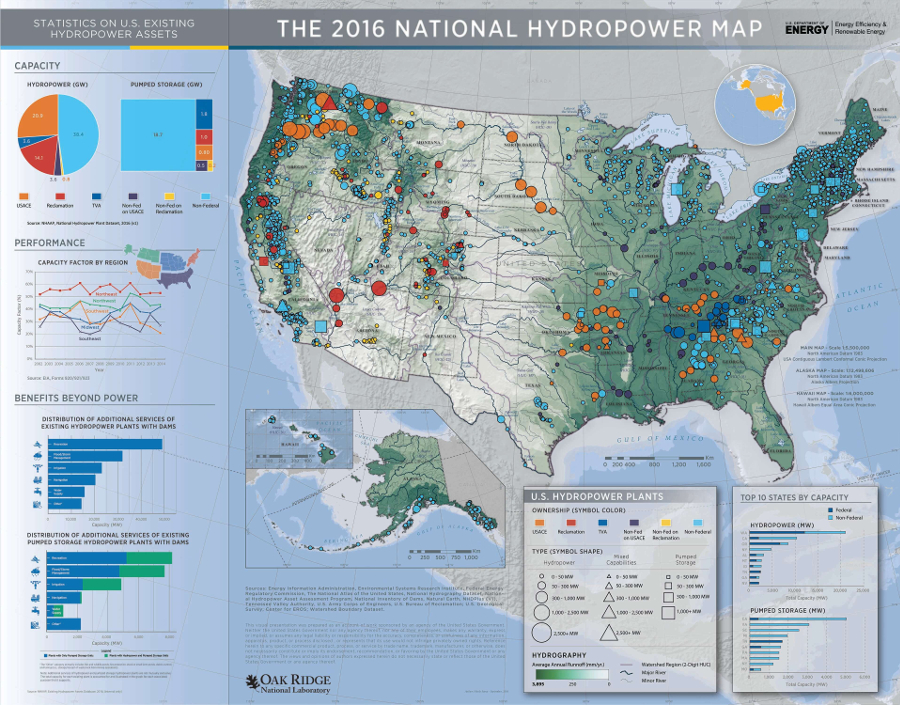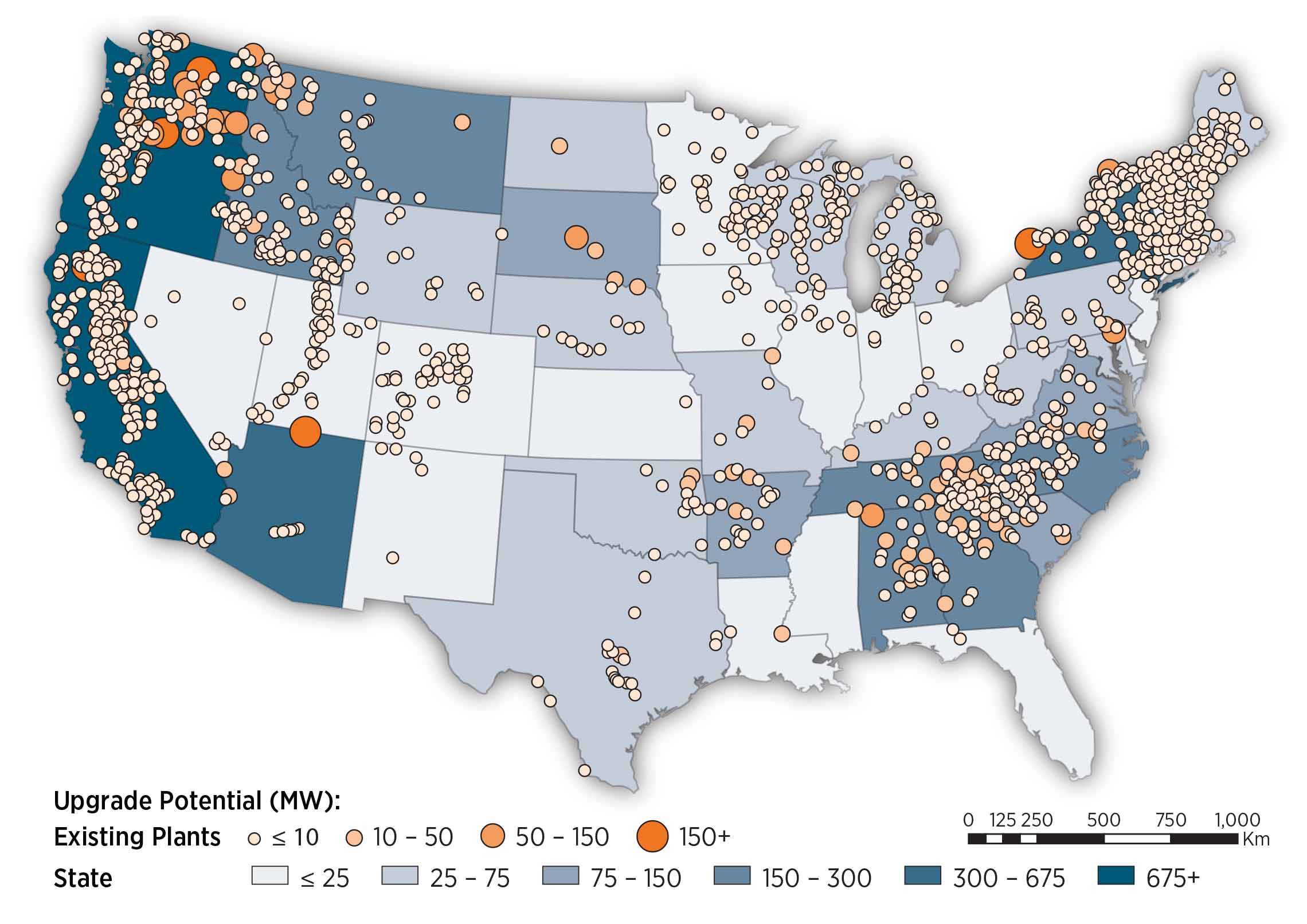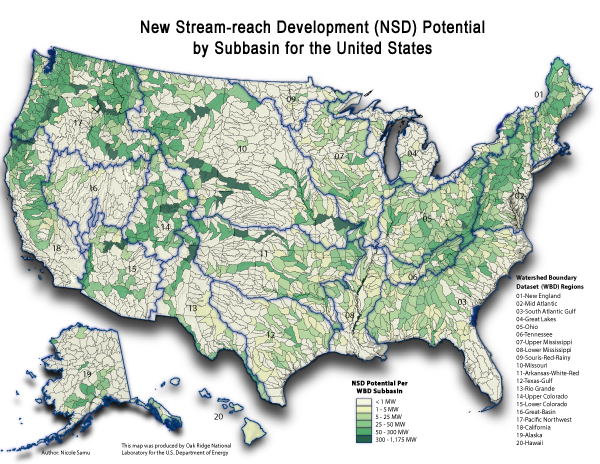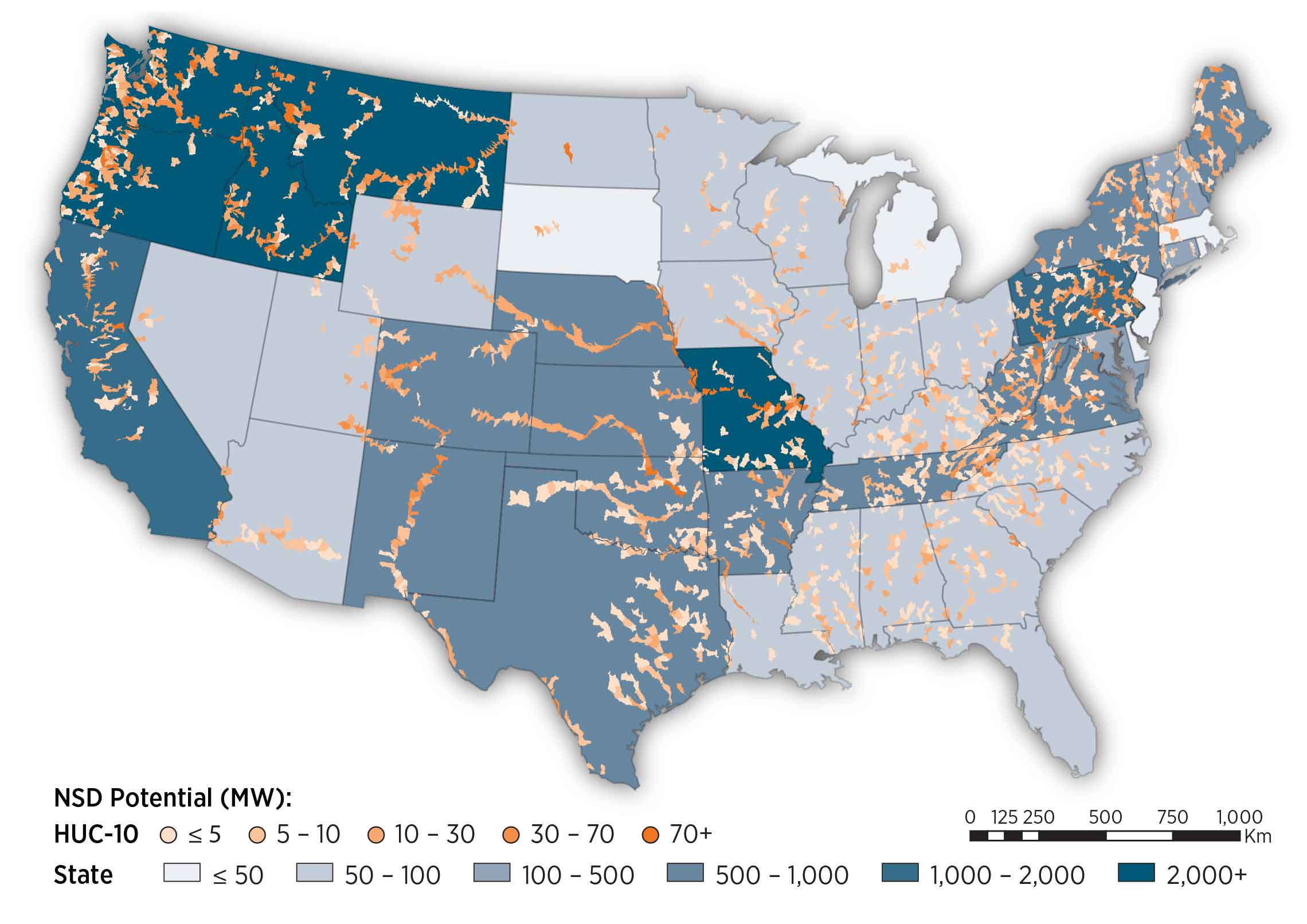Annual Technology Baseline 2018
National Renewable Energy Laboratory
Recommended Citation:
NREL (National Renewable Energy Laboratory). 2018. 2018 Annual Technology Baseline. Golden, CO: National Renewable Energy Laboratory. http://atb.nrel.gov/.
Please consult Guidelines for Using ATB Data:
https://atb.nrel.gov/electricity/user-guidance.html
Hydropower
Note: Pumped-storage hydropower is considered a storage technology in the ATB and will be addressed in future years. It and other storage technologies are represented in Standard Scenarios Model Results from the ReEDS model, and battery storage technologies are shown in the associated portion of the ATB.
Upgrades to Existing Facilities
Representative Technology
Hydropower technologies have produced electricity in the United States for over a century. Many of these infrastructure investments have potential to continue providing electricity in the future through upgrades of existing facilities (DOE (2016)). At individual facilities, investments can be made to improve the efficiency of existing generating units through overhauls, generator rewinds, or turbine replacements. Such investments are known collectively as " upgrades," and they are reflected as increases to plant capacity. As plants reach a license renewal period, upgrades to existing facilities to increase capacity or energy output are typically considered. While the smallest projects in the United States can be as small as 10-100 kW, the bulk of upgrade potential is from large, multi-megawatt facilities.
Resource Potential
The estimated total upgrade potential of 6.9 GW/24 TWh (at about 1,800 facilities) is based on generalizable information drawn from a series of case studies or owner-specific assessments (DOE (2015)). Information available to inform the representation of improvements to the existing fleet includes:
- A systematic, full-fleet assessment of expansion potential at Reclamation projects performed under the Reclamation Hydropower Modernization Initiative (see U.S. Bureau of Reclamation, "Hydropower Resource Assessment at Existing Reclamation Facilities")
- Case study reports from the U.S. Army Corps of Engineers (Corps) performed under its Hydropower Modernization Initiative (Montgomery, Watson, and Harza 2009)
- Case study reports combining assessments of upgrade and unit and plant optimization potential from the U.S. Department of Energy/Oak Ridge National Laboratory Hydropower Advancement Project.

https://nhaap.ornl.gov/2016-national-hydropower-map.
Renewable energy technical potential, as defined by Lopez et al. 2012, represents the achievable energy generation of a particular technology given system performance, topographic limitations, and environmental and land-use constraints. The primary benefit of assessing technical potential is that it establishes an upper-boundary estimate of development potential. It is important to understand that there are multiple types of potential-resource, technical, economic, and market (Lopez at al. 2012; NREL, "Renewable Energy Technical Potential").
Base Year and Future Year Projections Overview
Upgrades are often among the lowest-cost new capacity resource, with the modeled costs for individual projects ranging from $800/kW to nearly $20,000/kW. This differential results from significant economies of scale from project size, wherein larger capacity plants are less expensive to upgrade on a dollar-per-kilowatt basis than smaller projects are. The average cost of the upgrade resource is approximately $1,500/kW.
CAPEX for each existing facility is based on direct estimates (DOI (2010)) where available. Costs at non-reclamation plants were developed using Hall et al. (2003).
No future cost and performance projections for hydropower upgrades are assumed.
Upgrade cost and performance are not illustrated in this documentation of the ATB for the sake of simplicity.

Standard Scenarios Model Results
ATB CAPEX, O&M, and capacity factor assumptions for the Base Year and future projections through 2050 for Constant, Mid, and Low technology cost scenarios are used to develop the NREL Standard Scenarios using the ReEDS model. See ATB and Standard Scenarios.
The ReEDS model times upgrade potential availability with the relicensing date, plant age (50 years), or both.
Powering Non-Powered Dams
Representative Technology
Non-powered dams (NPD) are classified by energy potential in terms of head. Low head facilities have design heads below 20 m and typically exhibit the following characteristics (DOE (2016)):
- 1 MW to 10 MW
- New/rehabilitated intake structure
- Little, if any, new penstock
- Axial-flow or Kaplan turbines (2-4 units)
- New powerhouse (indoor)
- New/rehabilitated tailrace
- Minimal new transmission (< 5 miles, if required)
- Capacity factor of 35% to 60%.
High head facilities have design heads above 20 m and typically exhibit the following characteristics (DOE (2016)):
- 5 MW to 30 MW
- New/rehabilitated intake structure
- New penstock (typically < 500 feet of steel penstock, if required)
- Francis turbines (1-3 units)
- New powerhouse (indoor)
- New/rehabilitated tailrace
- Minimal new transmission line (up to 15 MW, if required)
- Capacity factor of 35% to 60%.
Resource Potential
Up to 12 GW of technical potential exists to add power to U.S. NPD. However, based on financial decisions in recent development activity, the economic potential of NPD may be approximately 5.6 GW at over 54,000 dams in the contiguous United States. The majority of this potential (5 GW or 90% of resource capacity) is associated with less than 700 dams (DOE (2016)). These resource considerations are discussed below:

- According to the National Inventory of Dams, more than 80,000 dams exist that do not produce power. This data set was filtered to remove dams with erroneous flow and geographic data and dams whose data could not be resolved to a satisfactory level of detail (Hadjerioua, Wei, and Kao (2012)). This initial assessment of 54,391 dams resulted in 12 GW of capacity.
- A new methodology for sizing potential hydropower facilities that was developed for the new-stream reach development resource (Kao et al. (2014)) was applied to non-powered dams. This resource potential was estimated to be 5.6 GW at over 54,000 dams. In the development of the Hydropower Vision, the NPD resource available to the ReEDS model was adjusted based on recent development activity and limited to only those projects with power potential of 500 kW or more. As the ATB uses the Hydropower Vision supply curves, this results in a final resource potential of 5 GW/29 TWh from 671 dams.
- For each facility, a design capacity, average monthly flow rate over a 30-year period, and a design flow rate exceedance level of 30% are assumed. The exceedance level represents the fraction of time that the design flow is exceeded. This parameter can be varied and results in different capacity and energy generation for a given site. The value of 30% was chosen based on industry rules of thumb. The capacity factor for a given facility is determined by these design criteria.
- Design capacity and flow rate dictate capacity and energy generation potential. All facilities are assumed sized for 30% exceedance of flow rate based on long-term, average monthly flow rates.
Renewable energy technical potential, as defined by Lopez et al. 2012, represents the achievable energy generation of a particular technology given system performance, topographic limitations, and environmental and land-use constraints. The primary benefit of assessing technical potential is that it establishes an upper-boundary estimate of development potential. It is important to understand that there are multiple types of potential-resource, technical, economic, and market (Lopez at al. 2012; NREL, "Renewable Energy Technical Potential").
Base Year and Future Year Projections Overview
Site-specific CAPEX, O&M, and capacity factor estimates are made for each site in the available resource potential. CAPEX and O&M estimates are made based on statistical analysis of historical plant data from 1980 to 2015 (O'Connor et al. (2015a)). Capacity factors are estimated based on historical flow rates. For presentation in the ATB, a subset of resource potential is aggregated into four representative NPD plants that span a range of realistic conditions for future hydropower deployment.
Projections developed for the Hydropower Vision study (DOE (2016)) using technological learning assumptions and bottom-up analysis of process and/or technology improvements provide a range of future cost outcomes. Three different projections were developed for scenario modeling as bounding levels:
- Constant Technology Cost Scenario: no change in CAPEX, O&M, or capacity factor from 2015 to 2050; consistent across all renewable energy technologies in the ATB
- Mid Technology Cost Scenario: incremental technology learning, consistent with Reference in Hydropower Vision (DOE (2016)); CAPEX reductions for new stream-reach development (NSD) only
Standard Scenarios Model Results

ATB CAPEX, O&M, and capacity factor assumptions for the Base Year and future projections through 2050 for Constant, Mid, and Low technology cost scenarios are used to develop the NREL Standard Scenarios using the ReEDS model. See ATB and Standard Scenarios.
ReEDS Version 2017. 1 standard scenario model results restrict the resource potential to sites greater than 500 kW, consistent with the Hydropower Vision, which results in 5 GW/29 TWh at 671 dams.
New Stream-Reach Development
Representative Technology
Greenfield or new stream-reach development (NSD) sites are defined as new hydropower developments along previously undeveloped waterways and typically exhibit the following characteristics (DOE (2016)):
- 1 MW to 100 MW
- New diversion/intake structure
- New penstock
- Steel with length being head/terrain dependent
- Various turbine selections
- Impulse/Francis are common for recently completed projects
- New powerhouse (indoor)
- New tailrace
- New transmission line (up to 15 miles for new projects)
- 30% to 80% capacity factor.
Resource Potential
The resource potential is estimated to be 53.2 GW/301 TWh at nearly 230,000 individual sites (Kao et al. (2014)) after accounting for locations statutorily excluded from hydropower development such as national parks, wild and scenic rivers, and wilderness areas.

- About 8,500 stream reaches were evaluated to assess resource potential (i.e., capacity) and energy generation potential (i.e., capacity factor). For each stream reach, a design capacity, average monthly flow rate over a 30-year period, and design flow rate exceedance level of 30% are assumed. The exceedance level represents the fraction of time that the design flow is exceeded. This parameter can be varied and results in different capacity and energy generation for a given site. The value of 30% was chosen based on industry rules of thumb. The capacity factor for a given facility is determined by these design criteria. Plant sizes range from kilowatt-scale to multi-megawatt scale (Kao et al. (2014)).
- The resource assessment approach is designed to minimize the footprint of a hydropower facility by restricting inundation area to the FEMA 100-year floodplain.
- New hydropower facilities are assumed to apply run-of-river operation strategies. Run-of-river operation means the flow rate into a reservoir is equal to the flow rate out of the facility. These facilities do not have dispatch capability.
- Design capacity and flow rate dictate capacity and energy generation potential. All facilities are assumed sized for 30% exceedance of flow rate based on long-term, average monthly flow rates.
Renewable energy technical potential, as defined by Lopez et al. 2012, represents the achievable energy generation of a particular technology given system performance, topographic limitations, and environmental and land-use constraints. The primary benefit of assessing technical potential is that it establishes an upper-boundary estimate of development potential. It is important to understand that there are multiple types of potential-resource, technical, economic, and market (Lopez at al. 2012; NREL, "Renewable Energy Technical Potential").
Base Year and Future Year Projections Overview
Site-specific CAPEX, O&M, and capacity factor estimates are made for each site in the available resource potential. CAPEX and O&M estimates are made based on statistical analysis of historical plant data from 1980 to 2015 (O'Connor et al. (2015a)). Capacity factors are estimated based on historical flow rates. For presentation in the ATB, a subset of resource potential is aggregated into four representative NSD plants that span a range of realistic conditions for future hydropower deployment.
Projections developed for the Hydropower Vision study (DOE (2016)) using technological learning assumptions and bottom-up analysis of process and/or technology improvements provide a range of future cost outcomes. Three different projections were developed for scenario modeling as bounding levels:
- Constant Technology Cost Scenario: no change in CAPEX, O&M, or capacity factor from 2015 to 2050; consistent across all renewable energy technologies in the ATB
- Mid Technology Cost Scenario: incremental technology learning, consistent with Reference in Hydropower Vision (DOE (2016)); CAPEX reductions for NSD only
- Low Technology Cost Scenario: gains that are achievable when pushing to the limits of potential new technologies, such as modularity (in both civil structures and power train design), advanced manufacturing techniques, and materials, consistent with Advanced Technology in Hydropower Vision (DOE (2016)); both CAPEX and O&M cost reductions implemented.
Standard Scenarios Model Results
ATB CAPEX, O&M, and capacity factor assumptions for the Base Year and future projections through 2050 for Constant, Mid, and Low technology cost scenarios are used to develop the NREL Standard Scenarios using the ReEDS model. See ATB and Standard Scenarios.
ReEDS Version 2017.1 standard scenario model results restrict the resource potential to sites greater than 1 MW, which results in 30.1 GW/176 TWh on nearly 8,000 reaches.
References
DOE (U.S. Department of Energy). 2015. Wind Vision: A New Era for Wind Power in the United States. U.S. Department of Energy. DOE/GO-102015-4557. March 2015. http://energy.gov/sites/prod/files/2015/03/f20/wv_full_report.pdf.
DOE (U.S. Department of Energy). 2016. Hydropower Vision: A New Chapter for America's Renewable Electricity Source. Washington, D.C.: U.S. Department of Energy. DOE/GO-102016-4869. July 2016. https://energy.gov/sites/prod/files/2016/10/f33/Hydropower-Vision-10262016_0.pdf.
DOI (U.S. Department of the Interior, Bureau of Reclamation). 2010. Assessment of Potential Capacity Increases at Existing Hydropower Plants: Hydropower Modernization Initiative. Sacramento, CA: U.S. Department of the Interior. October 2010. https://www.usbr.gov/power/AssessmentReport/USBRHMICapacityAdditionFinalReportOctober2010.pdf.
Hadjerioua, Boualem, Yaxing Wei, and Shih-Chieh Kao. 2012. An Assessment of Energy Potential at Non-Powered Dams in the United States. Oakridge, TN: Oakridge National Laboratory. GPO DOE/EE-0711. April 2012. http://www1.eere.energy.gov/water/pdfs/npd_report.pdf.
Hall, Douglas G., Richard T. Hunt, Kelly S. Reeves, and Greg R. Carroll. 2003. Estimation of Economic Parameters of U.S. Hydropower Resources. Idaho Falls, ID: Idaho National Laboratory. INEEL/EXT-03-00662. June 2003. http://www1.eere.energy.gov/water/pdfs/doewater-00662.pdf.
Kao, Shih-Chieh, Ryan A. McManamay, Kevin M. Stewart, Nicole M. Samu, Boualem Hadjerioua, Scott T. DeNeale, Dilruba Yeasmin, M. Fayzul, K. Pasha, Abdoul A. Oubeidillah, and Brennan T. Smith. 2014. New Stream-Reach Development: A Comprehensive Assessment of Hydropower Energy Potential in the United States. Oakridge, TN: Oakridge National Laboratory. April 2014. GPO DOE/EE-1063. http://nhaap.ornl.gov/sites/default/files/ORNL_NSD_FY14_Final_Report.pdf.
Lopez, Anthony, Billy Roberts, Donna Heimiller, Nate Blair, and Gian Porro. 2012. U.S. Renewable Energy Technical Potentials: A GIS-Based Analysis. National Renewable Energy Laboratory. NREL/TP-6A20-51946. http://www.nrel.gov/docs/fy12osti/51946.pdf.
Montgomery, Watson, and Harza. 2009. Hydropower Modernization Initiative, Phase I, Needs and Opportunities Evaluation and Ranking. Prepared for the U.S. Army Corps of Engineers Northwest Division Hydroelectric Design Center. Contract No. W9127N-08-D-0003. Task Order 001.
O'Connor, Patrick W., Scott T. DeNeale, Dol Raj Chalise, Emma Centurion, and Abigail Maloof. 2015. Hydropower Baseline Cost Modeling, Version 2. Oak Ridge, TN: Oak Ridge National Laboratory. ORNL/TM-2015/471. September 2015. http://info.ornl.gov/sites/publications/files/Pub58666.pdf.
ORNL (Oakridge National Laboratory). n.d. "New Stream-Reach Development Resource Assessment." National Hydropower Asset Assessment Program (NHAAP). http://nhaap.ornl.gov/nsd.

